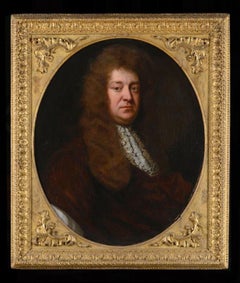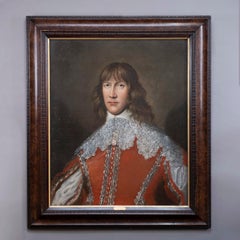This elegant large-scale portrait, presented by Titan Fine Art, is a fine example of Sir Godfrey Kneller’s court-style depiction of aristocratic and wealthy women. Beautifully composed, the sitter is three quarter length and seated within a wooded landscape. Pastoral backgrounds imply a virtuous character of unpretentious sincerity undefiled by the possession of great wealth and estates. The sitter wears an azure dress with a russet cloak elegantly draped over her arm and around her body. In this picture, we can see Kneller’s technique at its best, the excellent drawing of the face. It is painted with a delicacy that contrasts with Kneller’s more usual bold manner. The sitter is also unencumbered by high fashion or a background of stately topography. The emphasis is instead placed directly on the alluring femininity, and enhanced by the loose drapery and falling hair around her shoulder. We can see how Kneller often allowed the bluer ground layer to show through when suggesting the darker flesh tones. In both techniques, we should bear in mind Kneller’s own advice, when rebuking those who peered at his works too closely, ‘My paintings were not made for smelling of…’, and yet here the sitter’s face bears even the closest scrutiny.
In accordance with the sitter's age, and the style of clothing and hair, this portrait can be dated to the 1690s. Traditionally this portrait is thought to represent Susannah Papillon (nee Gregory) who was born on 13th Feb 1699 and married John Gregory Esq. However, the portrait was painted before her birth; the sitter is almost definitely her mother, Susannah Henshaw Papillon (1661-1707). Indeed, a portrait of “Susannah Henshaw, 2nd Wife of Philipp Papillon” (oil on canvas, 49.6 in. x 40.2 inches), sold at Dorotheum on October 4, 2000 [Lot 389], bears a striking resemblance to the sitter in our portrait.
Susannah Henshaw was a daughter of George Henshaw, a merchant and diplomat who served as British Consul in Genoa (d.1724). In 1695 she married Philip Papillon MP (1660-1736) as his second wife. The Papillon’s were a line of politicians and land-owning gentry whose family home was Papillon Hall and Acrise Place, in Kent (a house dating from the 16th century and held by the family from 1664 to 1850 and 1946 to 1986). The couple had issue: Thomas Papillon (c.1696-c.1714), Elizabeth Papillon (c.1697-1729), Phillip Papillon (1698–1746), Susannah Gregory Papillon (13 Feb 1699–), and Sarah Papillon (born 1701). As the portrait was painted in the 1690s, and with the inclusion of the sweetbriar roses in her hand, a representation of love, this portrait was almost certainly painted to celebrate the occasion of her marriage in 1695.
The Papillons were Huguenots. Thomas Papillon was Captain of the Guard to Henri IV of France but he sent his family to England in 1588 to avoid persecution as Protestants. His second son David (d.1659), an architect and military engineer built Papillon Hall in Lubenham (Leicestershire) in about 1620. He married as his second wife Anne Marie Calandrini, whose family had fled Italy as Protestants. Thomas (d.1702) the eldest son of this marriage purchased Acrise Place, Kent in 1664. He was a prominent merchant and campaigner for civil and religious freedoms as M.P. for Dover and then for London. His son Philip (d.1736) was also M.P. for Dover and married the sitter in our portrait. In the early 18th century Papillon Hall ceased to be used by the family and was sold to yeomen graziers. In 1850 the Papillons sold Acrise to William Mackinnon MP after whose death it was sold in 1908 to the Walney family, who occupied it until 1936. After standing empty for a time the house was used by the Army during the war and repurchased by Mr. A.H. Papillon, a descendant of the estate's original owner around 1946. The Folkestone Building Company purchased the property in 1986 and undertook a major programme of restoration. The main house is now divided into two separate properties, Acrise Place and Acrise Court.
Although history records what became of the sitter’s husband (and his heir) it is not known which branch of the family held this portrait in the eighteenth and nineteenth centuries. It is possible that a collection of art and furniture, which may have included this picture, was reassembled at the time of Acrise Place's re-acquisition around 1946.
The painting was recently located at Dewlish House, near Dewlish. The house is one of Dorset’s most beautiful country houses and is Grade I Listed. It was built in the Queen Anne/Georgian style in 1702 by Thomas Skinner, on the site of a large Roman villa. The property is set in 296 acres of picturesque parkland with farmland, forests, and a private lake. It was owned for two centuries by the Michel family and their descendants, including Sir John Michel, a notable soldier who served in the Crimean War. Anthony Boyden purchased the property in 1962, representing only the second time the property was sold in its 300-year history.
This exquisite painting is held in its outstanding original hand carved and gilded frame – a work of art in itself and is in excellent condition.
Sir Godfrey Kneller (1646-1723) dominates our understanding of
British portraiture...




